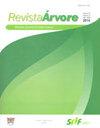油棕杂种愈伤组织胚性特征的诱导与维持manicorÉ
IF 0.8
4区 农林科学
Q4 FORESTRY
引用次数: 0
摘要
油棕(Elaeis guineensis Jacq.)由于其独特的根尖分生组织,给大规模繁殖带来了困难。在这种情况下,微繁殖允许离体苗的繁殖和种质精英的储存。本研究旨在通过低浓度生长素诱导油棕叶片发生胚性愈伤组织,并观察其在离体培养过程中这些特性的维持情况。在Y3培养基中分别添加Picloram(4-氨基-3,5,6-三氯-2-吡啶羧酸)或2,4-d(2,4-二氯苯氧乙酸),浓度分别为0、1、3、6和9 mg L-1, 0.5 cm叶片外植体诱导出愈伤组织。对具有胚性外观的愈伤组织进行传代培养,并通过细胞化学分析评价其胚性特征的维持情况。诱导愈伤组织的最佳处理剂量为1mg。L-1,导致30%的愈伤组织形成。根据颜色和形态将愈伤组织分为4种类型。外观呈结节状、米黄色的愈伤组织细胞具有胚性特征,培养20个月后细胞团的胚性保持不变。这种对协议的差异化适应可以通过组织培养在油棕的大规模繁殖中取得进展,这表明了调查该研究提出的主题的重要性。本文章由计算机程序翻译,如有差异,请以英文原文为准。
INDUCTION AND MAINTENANCE OF EMBRYOGENIC CHARACTERISTICS OF CALLUS OF THE OIL PALM HYBRID MANICORÉ
ABSTRACT Large-scale oil palm propagation (Elaeis guineensis Jacq.) is difficult due to its unique apical meristem. In this context, micropropagation allows the multiplication of seedlings in vitro and the storage of germplasm elites. This study aimed to induce embryogenic calluses from leaves of oil palm plants in low concentrations of auxins and to observe the maintenance of these characteristics during in vitro cultivation. Calluses were induced in 0.5 cm leaf explants in Y3 culture medium supplemented with Picloram (4-Amino-3,5,6-trichloro-2-pyridinecarboxylic acid) or 2,4-D (2,4-dichlorophenoxyacetic acid), at concentrations of 0, 1, 3, 6, and 9 mg L-1. The callus with embryogenic appearance was subcultured and evaluated regarding maintenance of embryogenic characteristics by cytochemical analyses. The best treatment for induction of calluses was composed of 1mg.L-1 of Picloram, which led to 30% callus formation. The calluses were classified into4 types, based on color and morphology. The cells of calluses with nodular and beige appearance have embryogenic characteristics, and the embryogenic potential of the cell masses was maintained over the 20 months of cultivation. This differentiated adaptation to the protocol can allow the advance in the mass propagation of oil palm through tissue culture, indicating the importance of investigating the topics proposed by the research.
求助全文
通过发布文献求助,成功后即可免费获取论文全文。
去求助
来源期刊

Revista Arvore
FORESTRY-
CiteScore
1.00
自引率
0.00%
发文量
32
审稿时长
4-8 weeks
期刊介绍:
A Revista Árvore é um veículo de comunicação científica da Sociedade de Investigações Florestais – SIF. O jornal é de acesso gratuito, revisado por pares, que publica bimestralmente trabalhos científicos originais no campo da Ciência Florestal. As áreas temáticas para publicação são: Ambiência e Conservação da Natureza, Manejo Florestal, Silvicultura e Tecnologia da Madeira e Utilização de Produtos Florestais.
A política editorial visa manter alta conduta ética em relação à publicação e aos seus funcionários, rigor na qualidade dos artigos científicos, seleção de revisores qualificados, respeito profissional aos autores e processo de tomada de decisão imparcial. A Revista Árvore publica artigos apenas em inglês.
Artigos de revisão podem ser publicados se houver uma discussão relevante resumindo o estado da arte sobre o assunto. A revisão estrita da literatura não é aceita.
 求助内容:
求助内容: 应助结果提醒方式:
应助结果提醒方式:


